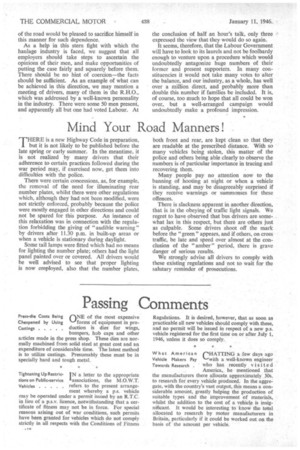Passing Comments
Page 20

Page 21

If you've noticed an error in this article please click here to report it so we can fix it.
Press-die Costs Being nNE of the most expensive Cheapened by Using forms of equipment in pro Castings duction is dies for wings, bumpers, hub caps and other articles made in the press shop. These dies are normally machined from solid steel at great cost and an expenditure of considerable time. The latest method is to utilize castings. Presumably these must be in specially hard and tough metal.
Tightening Up RestricN a letter to the appropriate tions on Public-service 'associations, the M.O.W.T.
Vehicles refers to the present arrange ment whereby a p.s. vehicle may be operated under a permit issued by an R.T.C. in lieu of a p.s.v. licence, notwithstanding that a certificate of fitness may not be in force. For special reasons arising out of war conditions, such permits have been granted for vehicles which do not comply strictly in all respects with the Conditions of Fitness Regulations. It is desired, however, that as soon as practicable all new vehicles should comply with these, and no permit will be issued in respect of a new P.S. vehicle registered for the first time on or after July 1, 1946, unless it does so comply.
What American CHATTING a few days ago Vehicle Makers Pay with a well-known engineer Towards Research . who has recently visited America, he mentioned that the manufacturers there allocate approximately 30s. to research for every vehicle produced. In the aggregate, with the country's vast output, this means a considerable amount, greatly helping the production of suitable types and the improvement of materials, whilst the addition to the cost of a vehicle is insignificant. it would be interesting to know the total allocated to research by motor manufacturers in Britain, particularly if it could be worked out on the basis of the amount per vehicle. A Calendar AccomINCLUDED with a most pan ied by Anti-nationla rtistic calendar fr o m
alization Appeals . Burrows Transport, Ltd., came two interesting communications. One was a pamphlet against nationalization published by the R.H.A., the other a series of notes concerning the company, one of which was an appeal to its customers for help in the retention of free enterprise in the industry. Reference was also made to the several concerns with which Burrows Transport, Ltd., is associated.
Difficulties in Finding A T a meeting of the I.A.E., Flaws in Ball Bear'"on January 1, Mr. A.
ings Towle, during the discussion following his paper, ," Some Problems in the Development of High-duty Engines," made the somewhat startling assertion that 8 out of 12 ball bearings supplied for aero-engines are, on close inspection, found to be flawed. The defects come to light only under the process of etching, and such flaws are often so minute that they do not necessarily mean that the bearing would fail in service. One difficulty is, of course, that they can seldom be discovered by ordinary inspection methods, but 'only by a treatment which destroys their value. This appears to indicate that something better than the standard methods of testing is necessary.
Plating Lead-bronze THE most recent practice of
Bearings With Pure some makers of oil engines
•
Lead is to plate the lead-bronze bearings with pure lead. The best thickness appears to be .001 in.; if more, the lead is apt to squash out. The exact purpose of carrying out this procedure is difficult to explain, and it has been asked why the lead-bronze should be used if the pure lead is to act as the real anti-friction surface. The answer is that if the lead be removed in service, what may be termed the "under bearing" carries on with the task. There may be a more scientific explanation for the employment of such lead coatings.




























































